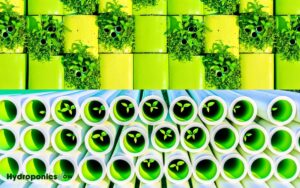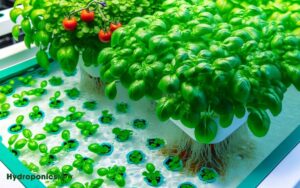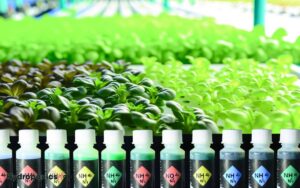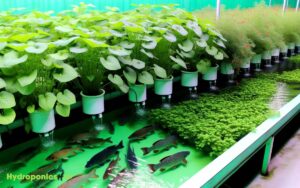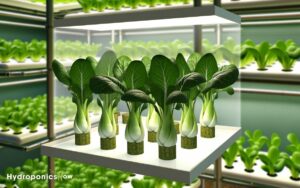Hydroponics Is a Type of Gardening That You Can: Explained!
Hydroponics is a type of gardening that you can implement without soil, utilizing nutrient-rich water solutions to boost plant growth and yields. It provides notable water savings, achieving up to 90% reduction compared to traditional methods.
Vertical gardening maximizes space usage, enhancing crop density by up to 30%. This method accelerates plant growth rates by delivering nutrients directly to roots, with plants growing up to 50% faster.
Additionally, hydroponics allows precise control over environmental factors such as light and temperature, minimizing pest risks and promoting healthier produce. Understanding these benefits can transform your gardening approach significantly.

Key Takeaways
Grow Without Soil
Hydroponics, a method of growing plants without soil, utilizes nutrient-rich water solutions to deliver essential minerals directly to plant roots.
This soilless cultivation system enhances plant growth rates and yields by optimizing nutrient availability and root aeration. Research indicates that hydroponic systems can produce crops up to 50% faster than traditional soil-based methods.
The absence of soil also minimizes the risk of soil-borne diseases and pests, thereby reducing the need for chemical pesticides.
Key components include inert growing media such as perlite or coco coir, which support plant structure without contributing nutrients. Precision in nutrient solution composition and pH levels is critical, as even minor imbalances can impact plant health.
Hydroponics offers a controlled environment conducive to year-round agricultural productivity.
Save Water Efficiently
One of the significant advantages of hydroponic gardening is its ability to use water more efficiently than traditional soil-based agriculture. Hydroponic systems achieve up to 90% water savings compared to conventional methods.
This efficiency is attributed to several factors:
- Recirculation: Water is recirculated in a closed-loop system, minimizing waste.
- Targeted Delivery: Nutrient solutions are delivered directly to plant roots, reducing evaporation and runoff.
- Reduced Evaporation: Controlled environments, such as greenhouses, limit water loss due to evaporation.
- No Soil Water Loss: Absence of soil eliminates water absorption by non-plant materials.
These factors collectively contribute to significant water conservation, making hydroponics an attractive option in regions facing water scarcity.
Maximize Space Usage
Hydroponic systems excel in space utilization through vertical gardening techniques, allowing for increased plant density per square meter.
Efficient water usage complements these compact system designs, contributing to a reduction in spatial footprint by eliminating the need for traditional soil and extensive irrigation setups.
Data indicates that vertical hydroponic systems can enhance crop yields by up to 30% compared to conventional methods.
Vertical Gardening Techniques
Vertical gardening techniques frequently optimize spatial efficiency by utilizing multi-tiered systems and wall-mounted planters. These methods are particularly advantageous in urban environments where ground space is limited.
Analytical data suggest that vertical gardening can increase yield per square meter by up to 200%.
This is achieved through various strategies such as:
- Stacked Planters: Multiple layers of planters elevate the grow area vertically.
- Green Walls: Wall-mounted systems that incorporate hydroponic channels for nutrient delivery.
- Tower Gardens: Cylindrical structures with multiple planting sites around the circumference.
- Shelving Units: Adjustable shelves that can be reconfigured to accommodate plant growth stages.
These systems not only maximize spatial utilization but also enhance microclimate control, leading to more consistent growth conditions.
Efficient Water Usage
Frequently, efficient water usage in hydroponics systems can reduce water consumption by up to 90% compared to traditional soil-based gardening methods.
This remarkable efficiency is achieved through a closed-loop system where water is recirculated, greatly minimizing wastage.
Data shows that hydroponic systems use approximately 70-100 liters of water per square meter annually, while conventional methods can require up to 1,000 liters for the same area.
This efficiency is not just beneficial for conserving water resources; it also reduces operational costs.
Analytical models indicate that ideal nutrient delivery and reduced evaporation are key factors in this water-saving capability.
Understanding these mechanisms allows for more sustainable and economically viable agricultural practices, making hydroponics a compelling choice for modern cultivation.
Compact System Designs
In what ways can compact system designs in hydroponics optimize spatial efficiency to accommodate higher crop yields per square meter? Compact systems leverage vertical space and modular configurations to enhance productivity.
Key strategies include:
- Vertical Farming: Utilizes multi-tiered structures to stack plants, effectively increasing usable area.
- Nutrient Film Technique (NFT): Employs narrow channels for nutrient-rich water, allowing dense plant spacing.
- Aeroponics: Suspends roots in mist environments, reducing required space for substrate.
- Modular Units: Facilitates scalable and customizable layouts, adapting to various spatial constraints.
These methods collectively maximize utilization of available space, enhancing crop yield efficiency. Data indicates that vertical farming, for instance, can produce 10 times the yield per square meter compared to traditional farming methods.
Boost Plant Growth
Optimizing nutrient delivery and environmental control, hydroponic systems greatly accelerate plant growth compared to traditional soil-based methods.
By delivering nutrients directly to the plant roots in a soluble form, hydroponics guarantees efficient absorption rates.
Studies indicate that hydroponically grown plants can exhibit growth rates up to 50% faster than their soil-grown counterparts.
Key factors contributing to this accelerated growth include precise pH management and tailored nutrient solutions, which mitigate nutrient deficiencies and toxicities.
Additionally, reduced disease incidence due to the absence of soil-borne pathogens further enhances plant health. Furthermore, consistent water availability and oxygenation improve root health, fostering robust plant development.
Consequently, hydroponics presents a highly efficient method for maximizing plant growth within controlled environments.
Control Plant Environment
The remarkable growth rates observed in hydroponic systems are largely attributable to the precise control over environmental conditions, such as light, temperature, and humidity. This controlled environment allows for optimization, leading to healthier and faster-growing plants.
Key factors to manage include:
- Light Intensity and Duration: Utilizing LED grow lights allows for tailored light spectrums, enhancing photosynthesis efficiency.
- Temperature Regulation: Maintaining ideal temperatures (typically 20-25°C) ensures peak metabolic rates and nutrient uptake.
- Humidity Control: Keeping relative humidity between 40-60% prevents issues like mold while promoting transpiration.
- Nutrient Solution Composition: Customizing nutrient mixes ensures plants receive precise amounts of essential minerals, resulting in superior growth outcomes.
This meticulous control fosters an environment where plants thrive, minimizing external stressors.
Reduce Pest Issues
Hydroponic systems greatly mitigate pest problems by eliminating soil, which is a primary habitat for many pests and pathogens.
Soilborne pests such as nematodes and fungal pathogens like Fusarium are commonly associated with traditional soil-based gardening.
Data shows that hydroponic environments reduce the incidence of these pests by up to 90%, according to a study by the Journal of Plant Pathology.
Additionally, hydroponic systems often employ closed environments, such as greenhouses, which further limit pest access.
This controlled environment allows for targeted pest management strategies, reducing the need for broad-spectrum chemical pesticides.
Consequently, hydroponic gardening not only decreases pest-related crop losses but also promotes a healthier, more sustainable method of cultivation with fewer chemical inputs.
Experiment With Plants
Leveraging the pest-reducing advantages of hydroponic systems, researchers and cultivators can experiment with a wider variety of plants, optimizing growth conditions for each species.
This capability enables the precise control of variables such as nutrient composition, pH levels, and light exposure. Data-driven methodologies can greatly enhance plant growth and yield.
Here are some experimental approaches:
- Nutrient Solution Trials: Adjust concentrations of essential minerals to determine the best growth conditions.
- Light Spectrum Variations: Test different wavelengths of light to enhance photosynthesis and growth rates.
- pH Level Adjustments: Fine-tune pH levels to ascertain the most favorable range for specific plant species.
- Temperature Control: Experiment with temperature settings to identify the ideal thermal environment for various plants.
Enjoy Fresher Produce
Hydroponic systems enable access to nutrient-rich harvests, leading to produce with higher nutrient content compared to traditional soil-grown crops.
Additionally, controlled environments facilitate year-round growth, ensuring a continuous supply of fresh produce regardless of external seasonal constraints.
This method results in improved food quality and availability, making it a viable solution for urban and indoor farming.
Nutrient-Rich Harvests
Cultivating plants through hydroponics results in nutrient-dense produce, thanks to the precise control of the growing environment and nutrient solutions.
This method guarantees the best uptake of essential minerals and vitamins, leading to higher nutritional content in the harvested crops compared to traditional soil-based methods.
Analytical data supports that hydroponically grown vegetables can achieve up to 50% higher nutrient levels.
To maximize the benefits of hydroponics, consider the following:
- Monitor Nutrient Solutions: Regularly check and adjust nutrient levels to meet specific plant needs.
- Control pH Levels: Maintain an ideal pH range (5.5-6.5) for nutrient absorption.
- Ensure Adequate Lighting: Provide consistent, appropriate light for photosynthesis.
- Implement Pest Management: Use integrated pest management (IPM) to protect crops without harmful chemicals.
These steps will help you enjoy fresher, more nutrient-rich produce.
Year-Round Growth
Utilizing hydroponic systems enables year-round plant growth, providing a consistent supply of fresh produce regardless of seasonal variations.
This is achieved through controlled environment agriculture (CEA), where ideal conditions are maintained for plant development.
Data from the University of Arizona indicates that hydroponic systems can produce yields up to 30% higher than traditional soil-based methods.
Additionally, these systems utilize up to 90% less water, making them highly efficient in resource utilization.
Conclusion
Hydroponics, a soil-free gardening method, offers numerous advantages including efficient water usage, maximized space utilization, accelerated plant growth, and enhanced pest control.
According to a study by the University of Arizona, hydroponic systems can reduce water consumption by up to 90% compared to traditional soil-based agriculture.
This innovative approach not only allows for precise environmental control but also facilitates experimentation with various plant species, resulting in fresher and more nutritious produce.

